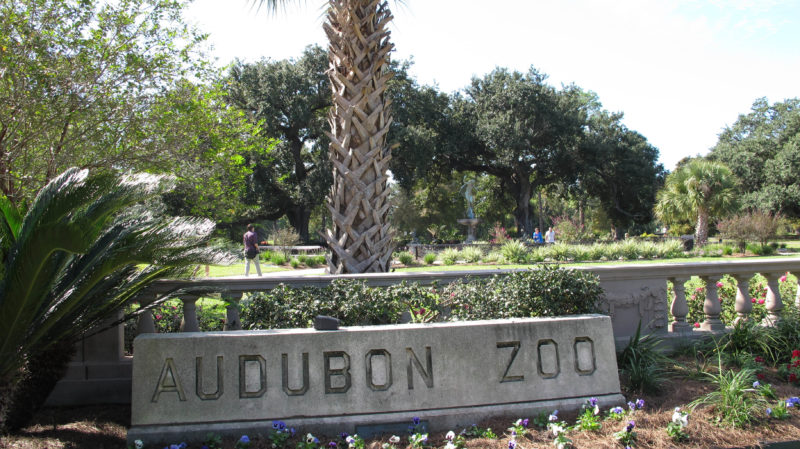
Audubon Zoo Entrance. Photo by Ed Blerman via the Creative Commons
The Audubon Zoo was created in 1914. However, its heritage and roots rest far deeper than the creation of New Orleans’ first zoo (Pontchartrain, Blake. “Where was Etienne De Bore’s Sugar Plantation? | Blake Pontchartrain: New Orleans Trivia | Gambit New Orleans News and Entertainment.” Gambit New Orleans News and Entertainment. N.p., 23 Nov. 2010. Web. 12 Nov. 2012). In 1795, Etienne de Bore, New Orleans’ first mayor, founded the nation’s first sugar plantation on the land that would eventually become Audubon Park. The plantation saw it’s largest transformations in the nineteenth century. During the Civil War the plantation was used as a confederate camp and, surprisingly, a hospital for union soldiers. Large improvements were made to the land after the war due to Louisiana’s first hosting of the World’s Fair. The improvements were greatly appreciated by the neighboring community and showed such promise that a plan to erect a city park was created (Audubon, “Audubon Institute.” Last modified 1/5/2012. Accessed November 5, 2012. http://www.auduboninstitute.org/about). Consequently, the city of New Orleans bought the land in 1871 and appointed preeminent landscape architect John Olmstead as chief of development. In 1886, Upper City Park became known as Audubon Park. It was named after the infamous artist and naturalist John Audubon. After a few decades of existence, a grateful community and a talented artist who captured the park’s ambiance, the city erected its first zoo in the heart of the New Orleans’ most scenic park. Since then, the zoo has thrived tremendously and undergone countless additions to perfect its image.
Activities and Programs
The Audubon Zoo offers many activities and programs to the public (Donze Frank with MediaNOLA, interview by Feinberg Daniel, “Interview,” Record, November 2, 2012:1). The most popular activities include Twilight Zoo, Swamp Fest, Earth Fest, Putumayo Family Festival, All Snakes Day, Zoo Year’s Eve, and ECCO (Education, Conservation and Community Operations). All of the activities and programs listed are inspired by a civically virtuous staff and administration dedicated to offering quality entertainment through the exhibition of nature and education.
Economic and Cultural Impact
The Audubon Zoo’s main incentive as a non-profit organization is to get the community involved interactively. This is simple for the community because all they must do is show up. The zoo hosts countless festivals, concerts and gatherings that all aim to provide a positive impact on the community (Audubon Zoo, “Community Relations.” Last modified 1/5/2012. Accessed November 5, 2012. http://www.auduboninstitute.org/community-relations). In 2011, the zoo aimed to improve its percentage of minority visitors to 35 percent of all visitors, as well as serving at least 242,000 undeserved visitors. The zoo achieved its minority visitor goal and exceeded the undeserved visitor goal by 30,000 plus visitors. Overall last year the zoo hosted 863,000 visitors, it’s most in over two decades. The Audubon Zoo has such a profound impact because they consistently reach and often exceed their civic and philanthropic goals.
Economically speaking, in 2011 the zoo made $20,021,970 in total revenue. It operated at $22,810,807, and thereafter found itself resting at $2,700,744 in capital expenditures. The Audubon Institute generally experiences its most expensive operating expenses and revenues in the zoo and park department. However, these expenses should not be taken lightly. Their capital expenditures have many gains, especially in regard to their civic operations (Audubon Zoo, “Annual Report.” Last modified 1/5/2012. Accessed November 5, 2012. http://www.auduboninstitute.org/about/annual-report).
Similar Organizations
There really are no similar organizations to the Audubon Zoo in New Orleans, Louisiana. However, the zoo has worked in tandem with HCA MidAmerica since 2005 in an effort to create a community relations program designed to engage children, minorities and underserved residents in New Orleans. Since the program’s enactment, over 1.7 million minority and underserved visitors have experienced the beauty, and education, of nature through the zoo. The zoo obtains these successful achievements through special partnerships with local business, schools, health organizations, places of worship and social service organizations (AAZA, “Accreditation.” Last modified 4/24/2009. Accessed November 5, 2012. http://www.aza.org/current-accreditation-list).





